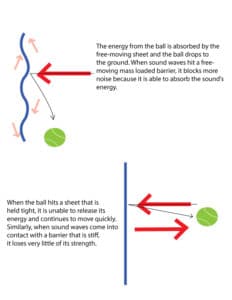Introduction
If you search ‘soundproofing’ in your preferred internet browser, you will likely run across a material called mass loaded vinyl (MLV), or several brand names for it. For instance, ours happens to be AudioSeal® Mass Loaded Vinyl (MLV) Soundproofing Barrier.
Many of my prospective customers calling about mass loaded vinyl mention that they would like to staple MLV to their sheetrock and then sheetrock right over it to soundproof a wall. That should stop the sound, right? Well… yes, but it would have worked so much better had it been allowed to move freely instead of pressed between two layers of sheetrock.
How Is Mass Loaded Vinyl (MLV) Used?
Another analogy would be that if you take a baseball and throw it at a bed sheet hanging from a clothesline, what happens to the ball? In a very short distance, the ball loses energy and drops to the ground. The sheet “bled” off the energy by being able to move in 3-Dimensional space. Now, I’m not going to bore you with Newton’s Three Laws of Motion, suffice it to say that if the sheet could not move, the ball would bounce, and whatever net energy was left in the sheet would result in vibration of the sheet.
Similarly, think about that in terms of sound. Sound hits the wall, bounces, net energy in the wall causes vibration, vibration in the wall vibrates air on the other side of the wall, vibration in the air on the other side of the wall hits your ears and you hear it. Now imagine that the wall is floppy like the sheet hanging from the clothesline… get where I’m going with this?
Obviously, the wall cannot be made to be floppy; but the soundproofing inside the wall can be floppy. In the science of acoustics, we call it a “Limp Mass Barrier.” This is typically why Mass Loaded Vinyl is recommended to be installed against the studs and then drywall over it. This allows the barrier to move in 3-dimensional space and bleed off the energy of the sound, resulting in greater net losses of sound propagation through the wall.
Why is Mass Loaded Vinyl (MLV) Important?
The introduction of mass loaded vinyl in the 1960s as an effective soundproofing option was a blessing for architects and engineers. MLV not only offers effective sound-reducing abilities but is also relatively easy to apply. MLV is typically attached to joists or studs, followed by covering seams and joints with acoustic caulking or barrier tape. Once sound caulking is applied, seams are sealed with tape to ensure optimal soundproofing performance.
MLV sound barriers block out most everyday noises people encounter, from traffic and construction sounds to noises from trains, buses, and even aircraft. It is a cost-effective solution to a variety of noise issues. As a DIY soundproofing material, MLV is one of the best options.
Examples of Mass Loaded Vinyl (MLV)
Tips And Reminders For Mass Loaded Vinyl (MLV)
But what if you can’t rip down your wall to put this stuff up? That’s fine, no need to, really. The solution here is to find the studs behind the existing sheetrock with a stud finder, mark them with a blue line, and screw in some furring strips vertically through the sheetrock into the studs.
What is a furring strip? It is a 1″ x 3″ piece of wood, kind of like a mini 2′ x 4′. After that, install the Mass Loaded Vinyl (I hope you call us for a quote on AudioSeal® Mass Loaded Vinyl (MLV) Soundproofing Barrier, we have some good deals on it) onto the furring strips, and then sheetrock over the whole thing. Easy-peasy, and you have retained the maximum potential for sound blocking that the product can offer.
But make sure to caulk all the seams and gaps in the sheetrock to ensure optimal soundproofing!
Summary
Mass Loaded Vinyl can be an effective, flexible, and affordable product for soundproofing when used correctly. On studio projects, movie theaters, and residential applications it can improve the Sound Transmission Class (STC) rating of a wall and help attenuate excess noise.
To learn more about how Acoustical Solutions can solve your noise control problems, use our contact form, call one of our Acoustical Sales Consultants at (800) 782-5742, or visit us on the web at acousticalsolutions.com.

